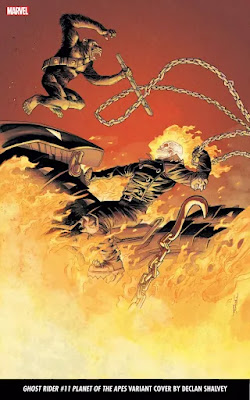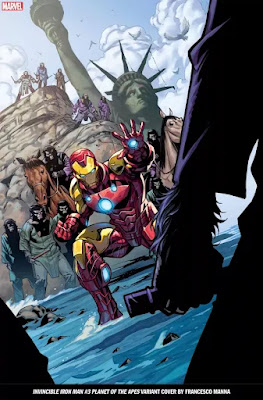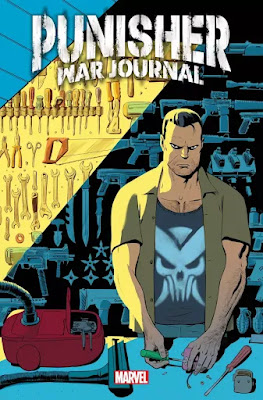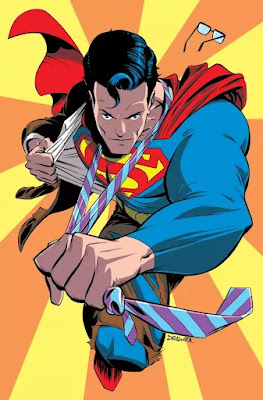When Gurihiru draws something, you don't ask, you just buy. In this case, you buy It's Jeff!, written by Kelly Thompson and starring the adorable little four-legged land-shark.
Saturday, December 31, 2022
Marvel's March previews reviewed
When Gurihiru draws something, you don't ask, you just buy. In this case, you buy It's Jeff!, written by Kelly Thompson and starring the adorable little four-legged land-shark.
DC's March previews reviewed
Electric Superman powers, like in the comics from 1998! Val-Zod from the New 52 Earth-2 series Earth 2, from 2012-2015! Ultraman, from Earth-3! You know, based on the solicit for Adventures of Superman: Jon Kent #1, the book doesn't sound too terribly new-reader friendly for a new #1.
Friday, December 30, 2022
A Month of Wednesdays: November 2022
BOUGHT:
Crypt of Shadows #1 (Marvel Entertainment) I came to Marvel's Halloween-season anthology special just a little too late, reading it in November rather than October. Named for a short-lived, 1973-1975 Marvel horror anthology, this revival is about what one would expect: Short stories featuring Marvel super-characters that are all vaguely horror-themed.
As you have likely deduced by now, such anthology specials constitute most of new comics diet; in fact, they're about the only comics I buy now that aren't trade collections. I was looking forward to this for that reason alone—it's been a while since I read a new Marvel comic book-comic—but I was also interested because of the presence of Man-Thing, seen on the variant cover I chose, and Adam Warren, a favorite creator who has been so involved in his own Empowered series that I haven't seen him do any work on anyone else's characters in what seems like forever.
Sadly, I was mostly disappointed with this $5.99, 40-page package, spending the majority of the time I was reading it in a state of mild confusion. (You can read a less wordy, more heavily illustrated version of this review of it in this Twitter thread.)
The book is "hosted" by Victor Strange, "brother of the dead doctor...condemned by misapplied magic to undeath in the half-world behind every mirror." He appears in segments written by Al Ewing and drawn by Ramon Bachs, each a one-page splash with an ornate frame around it to suggest we're looking at a fancy mirror in the titular crypt, "a sub-basement of sorts" to the Sanctum Sanctorum.
Victor explains that his story is common knowledge to the adept and that "you can probably read about it on your phone." Indeed, an asterisk leads to a small box saying to look for Strange Tales Infinity Comic on the Marvel Unlimited App. As an old-fashioned luddite who only reads comics on paper, I of course didn't do that, so, as far as I'm concerned, Victor is just the guy who shows up every eight pages or so of this book to introduce the next story.
The first of these features some ordinary-seeming girl named Brielle, and is the work of writer Danny Lore and artist Karen S. Darboe. Brielle is on her way to a costume party when she happens upon two chatty strangers who are messing with a ghost. She stops them and puts the ghost at ease and then the story ends. It's not until I got to the last page of the book—not the story, but the entire book— that I got a hint as to who Brielle is; she's apparently Blade's daughter, based on the fact that a girl who looks like her appears in a box saying "And Bloodline..." (they never call her "Bloodline" in the story) "Will return...Bloodline: Daughter of Blade."
If this was an introduction to the character, it was a pretty lousy one, as it took an ad in the back of the book to explain who I was reading about. Based on the story itself, she's just a random girl who happened upon some magic and a ghost.
That's followed by "Werwolf By Moon Knight" by Rebecca Roanhorse and Geoff Shaw. It involves a werewolf who's not Jack Russel— I had read that Roanhorse was rebooting the premise, although I'm not sure if this is the new "Werewolf By Night" or just a random werewolf. Anyway, said werewolf and his friend are invited to a party at a fancy house, where the butler is a werewolf. The two werewolves fight until a luminous white Moon Knight, making a dramatic appearance in a window before smashing through it, intervenes to break it up.
The bad werewolf resumes his human shape when defeated, and Moon Knight ties him to the gate around the manor with a sign reading "Dirt Bag." "I'll let the police take it from here," Moon Knight says to himself, as if the cops are going to find the guy and run his ID to determine he's broken the state laws against lycanthropy or something.
Next up is Morbius, who it's hard to take too seriously these days after the relentless drubbing the character has taken on Twitter for his movie, and a Vicki, who I have never heard of, but is introduced as "The daughter of the Darkhold". This story, by writer Chris Cooper and artist Ibrahim Moustafa, contains an asterisk referring to events from Darkhold: Pages From The Book of Sin #15, which a quick Internet search tells me came out in 1993. This is a story based on events from a 29-year-old comic book, then...? That poor choice aside, the last panel was fairly satisfying.
The most straightforward story in the collection follows, Chris Codon and Fran Galan's "Down Came The Rain," in which Elsa Bloodstone teams up with the Human Torch to de-monster-ize Spider-Man, who has become a Man-Spider during off-panel shenanigans. It's not great shakes, but at least I could make sense of it and it wasn't based on a comic from when I was a teenager.
Finally there's the Warren-written-and-drawn "Endless Slaughter in the Infinite Swamp", in which Warren basically asks, "What if Laura Kinney met Man-Thing?" She does so, in this story, to recruit the shambling swamp monster for "that week's super-heroically desperate struggle to save the world and/or universe and/or the entirety of the infinite multiverse."
As to the "What If...?", well Warren posits that Man-Thing's putrid stench would replicate Laura's "trigger scent", plunging her into a berserker rage, which would, in turn, trigger Man-Thing's response to negative emotions and he would attack her. Because they both regenerate from nearly any wound, the two would fight endlessly, And because they are in the Nexus of All Realities, they could fight longer than the Earth itself survived, and thus they would battle eternally.
Warren's overstating Laura's regenerative abilities—she ages, for example, and would die of old age somewhere long before year 1000 of their death-loop—but as for a Warren-illustrated answer to the sort of question that fans so like to ask of one another, what if so-and-so fought so-and-so, it's an interesting enough exercise. Far more interesting than everything that came before it, anyway.
DC's Saved by the Belle Reeve #1 (DC Comics) In the DCU, there's a prison called Belle Reeve that the Suicide Squad operates out of. That's the origin of the title of this comic, which is a pretty dumb joke and believe you me, if there's one thing I know it's dumb jokes (Again, I tweeted my way through this book, if you'd like to see it reviewed in less wordy, more picture-y format). Title aside, the idea is an 80-Page Giant anthology of stories dealing with school in one way or another.
It's hard to pick a favorite—there are a couple of strong entries, including returns of a pair of canceled titles I used to enjoy—so let's just look at them all in order. Ready?
The first story is the return of Gotham Academy, reuniting the team of Becky Cloonan, Brenden Fletcher and Karl Kerschl. Entitled "Sophomore Year", it similarly reunites all the members of Detective Club, with the glaring omission of Olive, who has gone missing from school rather suddenly, and whose missing journal Maps is trying to find. It's odd that a story in an anthology like this would advance the plot of the ended series, but perhaps a revival is in the cards in the future, as it ends with the words "(NOT) THE END".
That's followed by "High School Lows", a Suicide Squad story by writer Tim Seeley and artist Scott Kolins, in which a very film-inspired version of the Squad—Harley, King Shark, Katana and The Weasel, looking exactly as he did in the film rather than the comics—are each given undercover assignments at a prestigious prep school by team leader Peacemaker. Thing go spectacularly badly, but the day is ultimately saved.
Next up is a Super Sons story set a few years ago, back before Jon was hyper-aged and he and Damian were both classmates at West-Reeve prep school (There was also a Super Sons story set in the past in the Halloween-themed DC's Terrors Through Time 80-page giant; apparently the Super Sons premise is living on, even if not in the present DCU). This one is by former Super Sons writer Peter J. Tomasi and artist Max Raynor. It's the first day of eighth grade for the boys, and they befriend Sydney, a non-binary classmate targeted by bullies.
That's followed by Dave Wielgosz-written, Mike Norton-drawn Green Arrow and Speedy story in which the latter is doing so poorly at school that the former grounds him from superheroics. It's a nice, fun story featuring the now little-seen superhero team and, set during the Silver Age of the Justice League and Teen Titans, it has plenty of guest-stars. I thought this and the Super Sons story were among the strongest entries in the collection.
Next is the return of Art Baltazar and Franco's Tiny Titans, wherein the Tiny version of the New Teen Titans visit Belle Reeve prison and meet the super-villains of the last Suicide Squad movie. Baltazar and Franco haven't missed a beat, and, were it not for the specific focus on specific now-famous characters like Peacemaker and Polka-Dot Man, this could easily have appeared in an old issue of the cancelled series.
Black Lightning makes a welcome return in a short story by Brandon Thomas and Craig Cermak which focuses on high school principal Jefferson Pierce's time serving as President Luthor's secretary of education. The focus of the story is how he was able to serve a president who was, well, evil, and I was relieved Thomas didn't have Pierce answer that he was there because he was afraid someone worse would take the job if he didn't or that he was there to be an adult in the room; the Luthor presidency hits differently now that we've had an actual, unequivocal villain as a president here in the real world. Thomas does take something from the Trump administration, staging a scene in which Luthor does that thing Trump used to do at cabinet meetings, going around the table and having everyone take a turn praising him. Their arrogance is perhaps the only thing Luthor and Trump have in common; while both might be technically evil, Luthor as at least brilliant and a successful businessman and chief executive. Trump's not an ingenious super-villain, but more like the two-bit criminals that Superman used to toss around in the Golden Age.
Next is an Azrael story by Dan Watters and the excellent Juan Ferreyra which contrasts the two forms of "education" the hero had, a normal-ish school education and "The System" mental programming that made him into his secret organization's avenging angel. Nice art on this one, although it felt weird reading about Azrael in 2022 to me, given how much I associate him with a particular era.
Finally Andrew Aydin and Nelson Daniel present a story in which Dick Grayson asks Barbara Gordon to prom. This one had some fun bits, but it was also a bit of a mess. I'll allow that maybe Dick and Babs went to high school together—although I'm pretty sure she was quite older than him when originally introduced—but this story has Dick as Nightwing in high school, and that was obviously not the case. (There's also a bit of weirdness with a button that transforms their formal wear into superhero costumes that didn't really make sense to me).
Overall, this was a pretty fun collection, with far more good stories than bad ones.
BORROWED:
Dark Ages (Marvel Entertainment) If the best "What If...?" stories are those that can be boiled down to a sentence or so and fit into the "What If...?" formulation, well then, Tom Taylor and Iban Coello's Dark Ages is not one of the best "What If...?" stories.And what's the world like when it's lost power permanently, thanks to the constant exposure of an EMP wave that no can seem to turn off? Well, that's not really the focus of the series, oddly enough. There's a four-year time jump, and the world seems mostly settled into a new status quo, with the superheroes running the free world from the seat of power in Wakanda and X-Men villain Apocalypse ruling all of Europe, with lots of familiar faces as allies, thanks to the influence of his henchman, The Purple Man.
Tony Stark, who lost part of his leg when the lights went out and he was in mid-flight, is kidnapped by Apocalypse's forces, and thus the heroes must launch a rescue mission to save him, an event that takes up most of the book's length. So it's pretty standard heroes vs. villains business, really.
This being an alternate future, however, Taylor is able to kill characters off with impunity, and this he does. He's also able to change things from the regular Marvel Universe, and he does this too by giving Spider-Man and MJ a spider-powered daughter and Black Panther and Storm a daughter of their own.
If you've read any of the hundreds of pages worth of Injustice comics that Taylor has done for DC, or hiss DCeased for that matter, this is pretty similar; an alternate version of a familiar universe in which anything can happen, with clever bits of dialogue that lighten up an otherwise bleak premise, and plot beats that appear to be the driver of the story, connective tissue added later to get from Moment A to Moment B.
Coello's art is pretty great. It's well within the standard superhero spectrum, but he's able to draw powerful, dynamic figures in action as well as quieter character moments and everything looks equally great. There's a small degree of redesigning that seems to have gone into the project, as various characters have new, time-jump related costumes or looks, and/or are updated for the current state of affairs (like a steam-powered Iron Man suit of armor, for example).
Wednesday, November 30, 2022
Marvel's February previews reviewed
There's a lot of them. At least one seems to suggest a potentially interesting story (the Silver Surfer one), some put characters in iconic moments from the film series (Iron Man), and some just throw some apes into a picture with the stars. As with all of Marvel's non-Conan licensed comics of late, it doesn't look like they will be doing an actual crossover with the Marvel Universe and Planet of the Apes any time soon, they are just variants. That's fine, I guess; I'm not really enough a fan of PotA to find the idea of Marvel heroes visiting that setting to be all that appealing. I'm much more interested in Predator stalking Spider-Man or Daredevil, though Marvel doesn't seem to be making that happen, either.
Nice, simple idea for a variant cover, executed nicely by Jan Bazaldua for Amazing Spider-Man #20.



















































